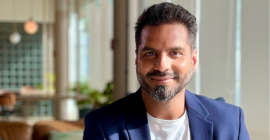‘Our Machine Learning & AI powered DSP delivers best RoI to brands’
By Rajiv Raghunath - April 17, 2023
Ben Elliott, Director - Advanced TV & DOOH of Toronto-based StackAdapt states that the platform was built from the beginning with AI as the brains which puts the company at a distinct advantage over other programmatic platforms. Edited excerpts of the interview with Rajiv Raghunath.
 As a DSP operating in multiple channels, how would you assess the growth potential of programmatic DOOH advertising? Are brands increasingly seeing the advantages of pDOOH advertising?
As a DSP operating in multiple channels, how would you assess the growth potential of programmatic DOOH advertising? Are brands increasingly seeing the advantages of pDOOH advertising?
Programmatic DOOH is experiencing significant growth as the OOH industry continues to digitise and adopt programmatic solutions. Brands and agencies are really driving this growth as they are quickly realising and embracing the benefits pDOOH can offer that historically wasn't easily achievable in traditional OOH (such as flexibility, real-time reporting/optimizations, cross channel retargeting, etc.).
From your experience, what brings brands to the StackAdapt DSP? Are you seeing more competition building up in the DSP space globally?
StackAdapt broke through the crowded ad tech industry as an entirely new type of demand-side platform fueled by machine learning and AI to help brands get the best possible return for their ad placements. StackAdapt stands out among competitors for its ability to adapt to new industry changes with ease. With evolving consumer ad preferences and privacy-driven changes, the business of digital advertising is entering a new era. Marketers are increasingly turning to AI and contextual advertising to tailor ads to the environment in which their audience is browsing, rather than the viewer themselves.
Many competitor solutions have begun to integrate AI into their programmatic offerings, but StackAdapt was built from the beginning with AI as the brains of the platform which puts the company at a distinct advantage over other programmatic platforms. The system is not only more effective but it emphasises contextual advertising capabilities that lead the charge for more privacy-compliant approaches to targeting in a cookieless environment.
What are your criteria for signing up with SSPs? How significant is your partnership with Place Exchange?
The criteria for new SSP partnerships are that StackAdapt must see the benefit rather than onboarding duplicated inventory access. For example, we need to see unique partnerships, SPO and brand safety initiatives, and a collaborative effort to help push the industry forward. The partnership with Place Exchange is vital as they not only check all these boxes, but are also leading the industry in innovation and willing to collaborate with StackAdapt on these solutions which ultimately benefits our buyers.
What are the typical challenges that come up as you look to build partnerships with different SSPs?
The challenges are mainly around lack of industry standardisation rather than SSP specific challenges. This is an emerging channel that's experiencing a high growth rate and with that comes growing pains. However, various industry working groups are working diligently to address this and make it a more streamlined and standardised process when it comes to technical projects/integrations with our SSP partners.
Do you have plans to broaden your business reach to cover emerging markets like India?
We ourselves are experiencing significant growth and with that comes the need to expand into new and emerging markets. India has been experiencing impressive growth in digital OOH transformation and DOOH ad spending. So, it is a market that is of interest as we continue to expand our DOOH offerings.

Stay on top of OOH media trends








